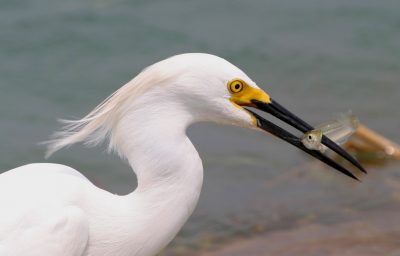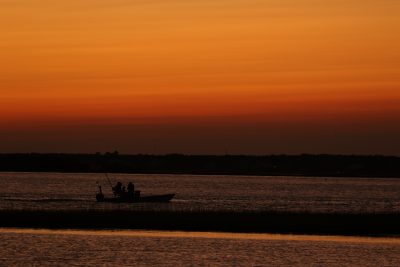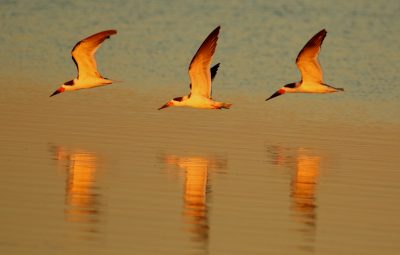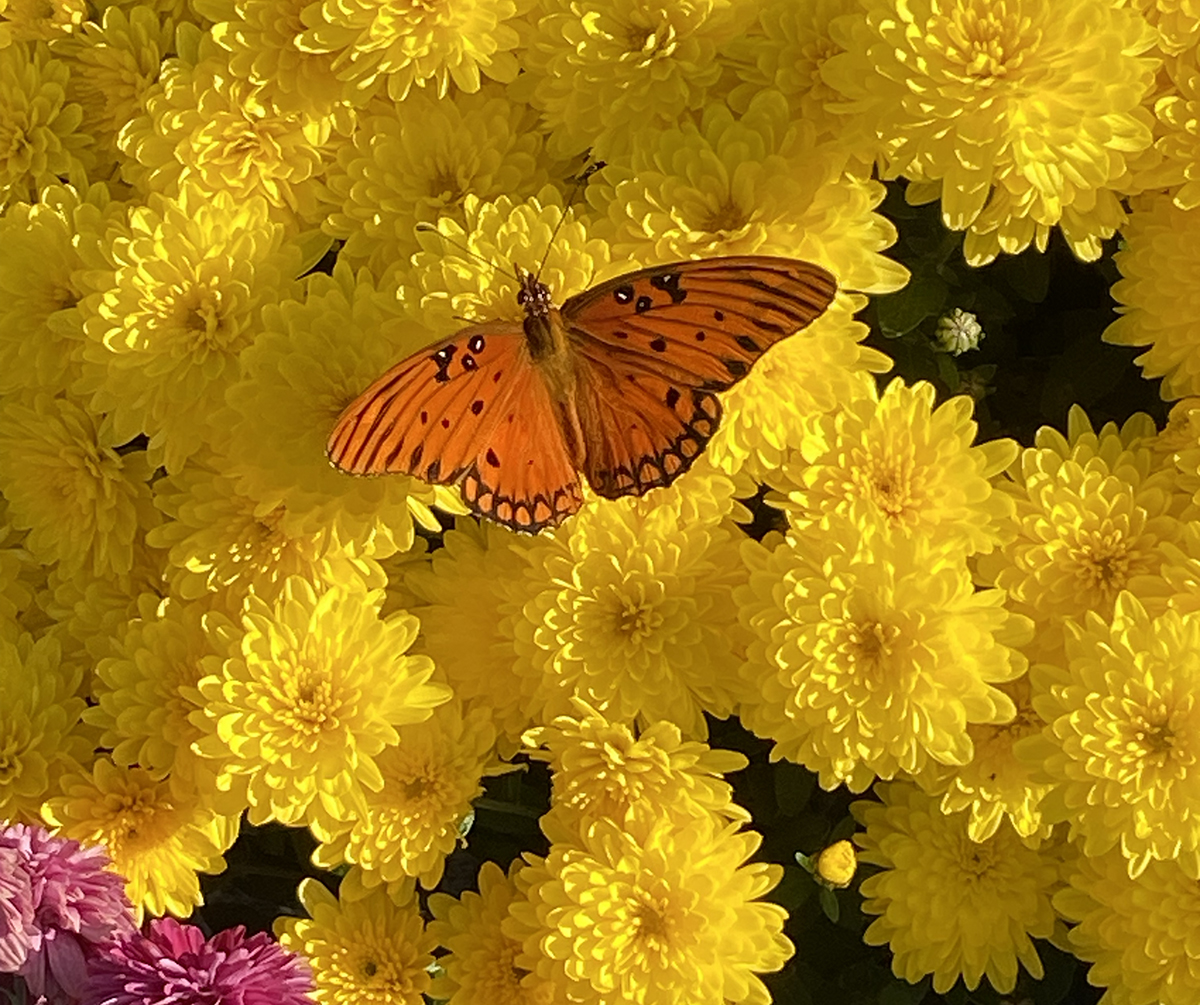
A lone snowy egret patrols the edge of the salt marsh just where the water meets the long slender strands of the bright green grass. Its white feathers appear to have been recently preened, creating an impeccable image of elegance.
With its slender neck reaching out past its body, it slowly walks the shoreline creating the illusion of a slow-motion video. Standing on one leg, the trailing leg gently pulls out of the water, revealing a bright yellow foot. Gradually, the leg continues forward as the bird deliberately searches for a meal. The egret retracts its long neck close to its breast as the entire body squats just above the water. As if a lightning bolt, the dagger-like bill launches into the water with a minor splash as tiny ripples spread out from the point of impact. With a 2-inch fish firmly clamped in its black bill, the egret stands erect and positions the fish for a headfirst slide down its throat.Supporter Spotlight

Egrets and herons are the iconic symbols, sentinels, if you will, of our coastal estuaries. These are the amazing places where the heavy salty ocean waters meet with the lighter fresh river waters to swirl together into a rich cocktail creating one of the most productive ecosystems on earth. Along the North Carolina coast, 300 miles of sandy barrier islands keep the ocean waves from pounding on the shore of the mainland. However, 20 inlets, from Oregon Inlet to Little River Inlet, cut through the barrier islands allowing the briny water to flood in behind the banks to mingle with the freshwater. A number of large, open, lagoon-like sounds, the Pamlico, Albemarle, Croatan, Currituck, Roanoke, Core and Bogue, form the largest estuary contained within a single state and the second-largest estuary in North America.
Over the years, tidal currents, wind, sediment, storms and the shape of the surrounding shoreline have conspired to create various habitats in and around these shallow waters. You can find a labyrinth of emerald green islands of smooth cordgrass salt marshes, shallow open waters, mudflats, sand flats, oyster reefs, seagrass beds, shorelines and tidal creeks. These habitats are so productive that estuaries are often referred to as nurseries or “cradles of the ocean.”
Because of the protection from the barrier islands, these waters are fairly well sheltered. This security creates a favorable environment for fish, shellfish and crustaceans to breed and live here. These “nurseries” provides habitat for spawning, feeding and protection from predators. It is estimated that more than 70 percent of the recreational and commercial seafood species spend part of, or their entire life in estuaries. This contributes billions of dollars and millions of jobs into the economy providing us with the fish, crabs, clams, scallops, oysters and shrimp we love to consume.
Supporter Spotlight
However, estuaries are more than just moneymakers, they are the sponges and filters that help reduce the chemicals, nutrients, sediments and pathogens in our coastal waters. Plants such as smooth cordgrass act as filters and stabilize shorelines as pollutants run off into the estuaries during rainstorms. Due to the high salinity, it is amazing that the prolific marsh grass can grow at all. Nevertheless, it can withstand the biting sting of the brine due to salt filters in its roots and the ability to exude salt through its leaves. Oysters and other filter-feeding shellfish strain out pollutants suspended in the water column. It is estimated that one oyster can filter close to 50 gallons of water a day. The estuarine systems reduce or eliminate the pesticides, insecticides, oils, fertilizer, bacteria, viruses and algae that are harmful to all the species that live in these waters.

Even those who do not care much for fishing or even eating seafood, crazy as they are, still flock to the coastal waters. Recreational swimming, boating, birdwatching and photography, along with the undeniable allure of being in proximity to estuaries, draw millions of visitors every year. For me, the greatest enticement of estuaries are their seductive beauty and charismatic wildlife and flora. The habitats that are above the tidal marshes in the form of hammocks or the maritime shrub thickets provide shelter, food and breeding services for native animals. You can find egrets, pelicans and herons that establish rookeries in the safety of an isolated island in the sound, or the oystercatcher that lays its eggs in a scrape among the shells of an old oyster reef. In the summer, painted buntings hide in the wax myrtle thickets, preparing their nests. I look forward to every fall when the pickleweed creates an explosion of bright red among the green salt marsh grass. Even the crowd-pleasing bottlenose dolphin cruises the estuary channels looking for food.
Our estuaries are in trouble though. For many years, numerous acres have been and still are being lost to land clearing, dredging, draining and filling associated with development. However, in 1972, estuarine sanctuaries were created through the Coastal Zone Management Act. Today, the National Estuarine Research Reserve throughout the Unites States and Puerto Rico manages 29 coastal areas. The national North Carolina reserve sites include Currituck Banks, Rachel Carson, Masonboro Island and Zeke’s Island. The mission of the sites is “To promote informed management and stewardship of North Carolina’s estuarine and coastal habitats through research, education and example.”
In 2000, the Estuary Restoration Act was established to advocate for the protection and restoration of coastal estuaries through the creation of a restoration plan between government and private groups. Nonprofit organizations such as Restore America’s Estuaries and the North Carolina Coastal Federation have led the way in restoring and protecting these vital habitats.
During the past 30 years, the federation has been preserving and restoring estuarine habitat. Here are just a few examples of their work:
- 3,000 acres of wetlands have been restore to eliminate polluted stormwater from entering our coastal waters.
- 47 living shoreline projects have been installed.
- 3 miles of fringing wetlands restored.
- 700,000 wetland plants and nearly 1 million native coastal trees and shrubs have been planted.
- 10,000 acres of conservation lands along the coast through conservation easements have been preserved.
- 200 stormwater retrofit projects such as rain gardens, cisterns and infiltration systems have been installed.
- More than 110 acres of oyster habitat, using over 200,000 bushels of native oyster shell and nearly 70,000 tons of marine limestone have been restored.

Get involved and volunteer with agencies that promote protecting and restoring our estuaries. Do your part by eliminating or reducing the use of insecticides, pesticides and fertilizers near coastal waters. Maintain a vegetative buffer on waterfront property. Use native plants for landscaping. Make sure septic tanks are working and dispose of pet waste properly.
This week, Restore America’s Estuaries and its partnering organizations are celebrating National Estuaries Week, Sept. 16-23, to raise awareness and appreciation of our coastal natural heritage. Even after this week, and throughout the year, you can have your own personal celebration of estuaries.
Anytime you see a group of black skimmers gracefully gliding inches above the water in the golden glow of a sunset, celebrate. Anytime you watch an osprey snatch a fish out of the sound, celebrate. Anytime you go for a refreshing swim, catch a fish or take a beautiful photograph of the marsh, celebrate. Anytime you paddle your kayak along a tidal creek, celebrate. Anytime you eat a shrimp dinner, celebrate. Well, you get the picture.








